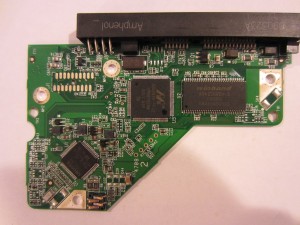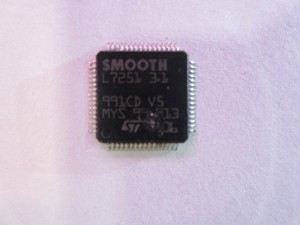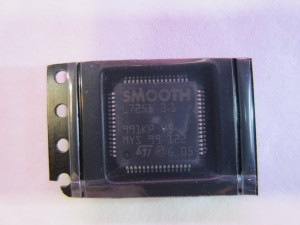I have a few Western Digital WD1001FALS 1 TB hard drives and they have been pretty reliable for the past few years until recently. One of my WD1001FALS’ died suddenly a few months ago. Since it was still under warranty, I sent the dead drive back to WDC and swapped for a replacement drive. A couple of weeks later however, another drive failed in a similar manner (the harddrive would not spin up). Instead of sending it back for another RMA, I decided to take a better look at what was causing the failure and see whether I could fix the drive myself.
Unlike a typical harddrive failure mode, in which you can hear the clicking noise from the drive heads trying to locate the tracks underneath, these drives simply stopped spinning. My suspicion is that the motor controller and/or possibly some other components have failed for some unknown reason. Initially I suspected that the power supply might be at fault, but after some repeated testing it seemed that all the voltages/ripples were well within specifications. Plus, I have two other hard drives in the same computer and neither of those drives were affected. So I began to think that it might have just been some unknown transient events that somehow only affected the two Western Digital drives specifically.
I pulled the dead drive out from the PC and unmounted the PCB. At first it appeared that everything looked normal (see picture below). The +12V and +5V pins on the SATA connector does not appear to have been shorted to the ground (there are protection TVS diodes on the power rails, in an over voltage event they are likely to be the first ones damaged. This usually manifests as a shorted power rail). But after some careful examination, the spindle motor driver chip marked as SMOOTH L2751 3.1 seemed to have suffered some thermal damage.

There was a tiny burned mark towards the lower right of the chip. It didn’t show up well in this picture, but you can see the damage clearly in the picture taken below after the chip was removed.

With no other signs of physical damage, I decided to take my chance by swapping out the spindle controller chip. Unfortunately there is not much information on the Internet about this particular chip, which is not surprising as these controller chips are aimed at highly specialized markets and are not designed for the typical consumers. The closest match I could find any information on is for ST’s L7250, presumably L7250 and L7251 are very closely related in terms of design and performance.
Sourcing L7251 V3.1 turned out to be another challenge. I could not find this chip anywhere in the US from any of the major component distributors. Eventually I ordered a couple from Aliexpress. After a few of weeks’ waiting, my order eventually arrived and the chips looked to be identical to the failed controller chip pictured earlier, the only differences appeared to be on the date codes and serial numbers.

Encouraged, I soldered the replacement chip onto the controller board using my hot air rework station. And to my great surprise the replacement chip actually worked right off the bat! The harddrive came back to life after I mounted the circuit board back on. Better yet, everything on the harddrive remains intact! To be honest, I didn’t expect it to be this easy (in general Murphy always wins).
Of course, I might have just been lucked out since the damage was apparently isolated within the spindle controller chip. Had there been an issue with the microcontroller chip, chances are that I wouldn’t be able to get the harddrive back in working condition again even if I were able to swap out the motor driver chip. This is because like most modern harddrives, WD1001FALS stores its calibration information within the MCU itself instead of on a separate EEPROM and that information varies from drive to drive. Without the calibration information, your chance of getting a working drive is pretty slim.
As to why the drive failed at the first place, I will probably never find out the true reason. It might have just been some totally random events, or it might have been some potential design flaws. Anyway, I did manage to fix the drive and now I have an extra L7251 V3.1 to spare, let me know in case you have a drive failed the same way and you wanted to give it a shot and try your luck…

